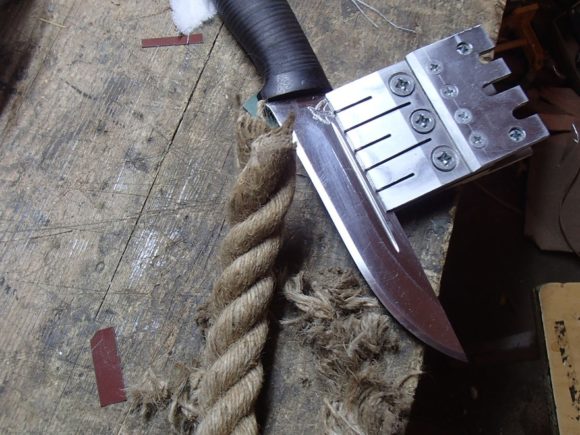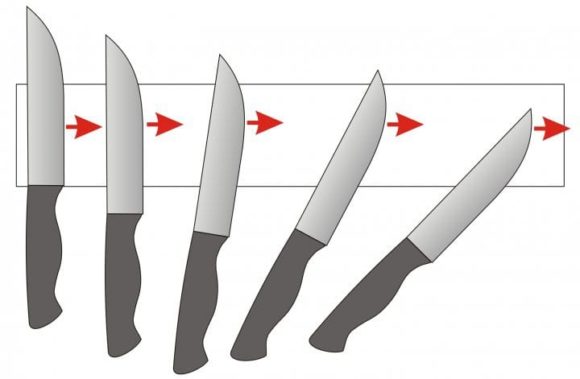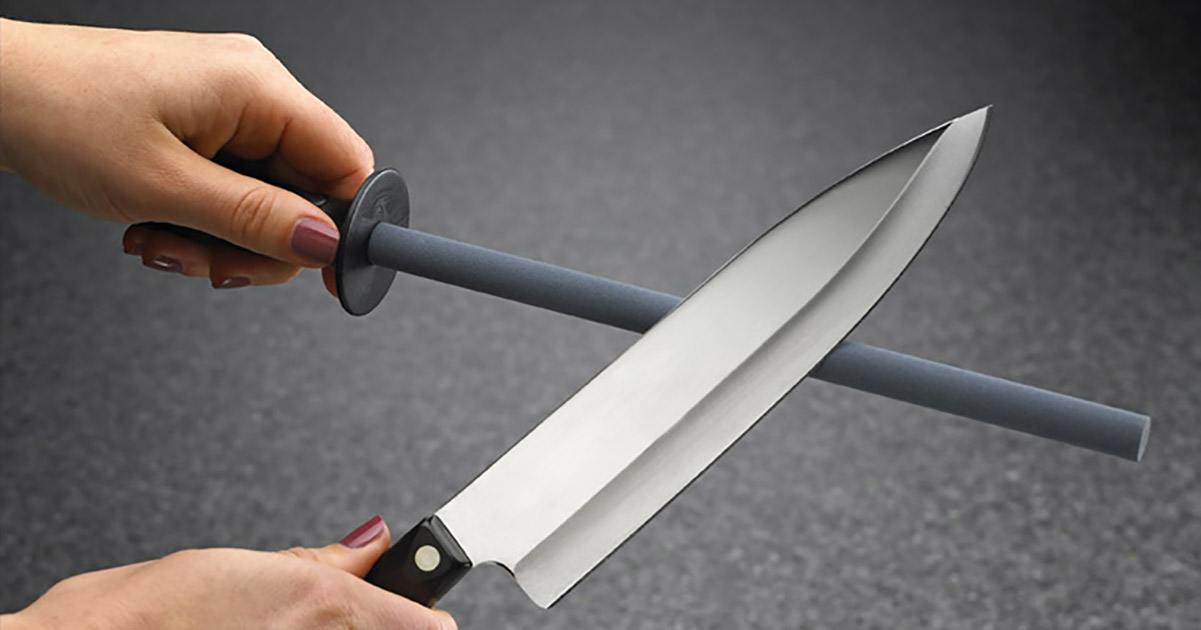Knives are used in many areas of life - during cooking and other activities, such a tool is indispensable. The main thing is its quality - sharpness, which cannot be maintained with constant use. To sharpen the knife correctly, you must follow a strict algorithm, take into account the characteristics of the material and maintain the angle of the edge.
Content
Materials and cutting angle
To sharpen the knife correctly, you need to find out the scope of its application and the material from which it is made. Depending on the material, its quality and manufacturing methods, it is distinguished that certain types will become dull faster, while others will not be re-sharpened at all - they are easier to replace with new ones. For the manufacture of these types of raw materials are used:
- Metals - steel, aluminum, titanium, stainless steel. Such a tool is durable and can be sharpened a large number of times. If the quality and strength are high, the sharpening frequency is 1 time per year, and when the raw materials are of poor quality, then more often.
- Ceramics. A tool made of this material is durable and maintains sharpness of the cutting edge for a long time. The main disadvantage is fragility. If a ceramic is dropped, it is highly likely that it will burst.
- Plastic belong to a disposable tool, due to the weakness of the material. To sharpen such a tool is possible only in a hopeless situation, as a temporary solution.

Before sharpening manually determine the desired angle of the edge of the blade. This parameter differs on different products depending on the direction of use and material. The angle greatly affects the overall sharpness of the product - the smaller the sharper. But, when the angle is large, the sharpness persists for a longer period. It can be defined manually or accepted as intended:
- 25-30 ° - hunting knives;
- 20 ° - universal tool;
- 15 ° - kitchen knives for domestic use;
- 10 ° - a professional tool (scalpels, razors, etc.).
It is not difficult to maintain the right angle when sharpening - you can use a drawing protractor or improvised tools. If you fold a square sheet of paper diagonally, you can get an angle of 45 ° - then proceed mathematically. To maintain the angle, you can fix the block at an angle, it is easier to sharpen the blade, leading from top to bottom.
Sharpening tool
For sharpening knives, there is an extensive number of devices - from classic stone to simplified household sharpeners. Depending on the quality, the price can range from 200 to 10,000 p. Ease of sharpening and tool life depend on this characteristic, but it must also be used correctly. Hand tools for sharpening edges include:
- Musat - often supplied complete with sets of kitchen knives, looks like a file of circular cross section. It is used to set the blade and remove burrs. For sharpening, you need to position the musat vertically, leaning on a plane and perform several sharp movements on each side of the blade.
- Bars or stones are a common tool for sharpening blades. There are coarse grains for edging and primary grinding, and fine grains for grinding the surface. There are natural and artificial origin. The surface of the whetstone should be flat.
- Manual knife sharpeners come in different configurations, but they do not need to track the angle - it is strictly set by the manufacturer.To sharpen the cutting edge with such a tool, it is necessary to insert the blade into the groove and energetically conduct 3-5 times.
Musati and sharpeners are used only for temporary mandrel blades. If you need to sharpen a knife, it is better to choose a bar. For household needs, the average grain size of the stone is suitable - a completely blunted blade can not be brought to razor sharpness, but such a tool will be cut. If sharpened according to all the rules, then different types of stone and a leather belt will be needed to fine-tune and polish the cutting part.
How to sharpen ceramics
Ceramic knives are distinguished by their own wear resistance - such a tool retains sharpness longer. With constant use, ceramics become dull after 1 year, after that sharpening is needed. However, the ceramic structure is fragile - such knives easily break. Sharpen ceramics without a special tool and experience is not recommended - it is better to contact the masters.
When sharpening a ceramic tool in the workshop, electric sharpeners with different circles are used and the structure of the material is taken into account. The blade after such processing, with the intended use, will hold sharpness for at least a year.
Method for sharpening a metal blade with a stone
When there is a whetstone on hand, sharpening a knife is straightforward. The main condition is safety standards - you can’t substitute hands under the blade, sharp movements should be directed away from you, and the sharpness test should only be done on food or paper. To sharpen the tool efficiently, you must strictly follow the instructions:
- The whetstone is securely fixed on the table - it should not fidget or swing.
- The surface of the stone is wetted with water or oil - this will provide better glide on the stone and no dust.
- The blade is driven along the bar from itself, as if cutting a thin layer. Be sure to maintain the initial angle of sharpening.
- Sharpening is finished when a burr appears on the blade - roughness is felt when moving the finger along the side.
- The cutting edge is drilled by the grinding bar in smooth movements.
A well-honed blade easily cuts paper on weight. To keep the sharpness for a longer period, it is recommended to polish the surface. To do this, repeat the steps when sharpening, but instead of using a damp bar, use a stretched leather belt rubbed over the surface with polishing paste. The most common type of such a tool is GOI paste.

Tool-free sharpening
You can quickly sharpen a knife at home without a special tool. This option may be suitable, if necessary, to sharpen the tool when at hand only household items are at hand. The easiest way involves editing the edge of the blade against another knife, for which several times vigorously hold the blade against the blade. Similarly, you can set the edge on the rough part of the bottom of the ceramic cup or plate. Acute and reliable sharpening in such ways cannot be achieved, but how a temporary solution will help.
You can replace the stone at home with an emery cloth, and instead of musat, a file of a similar configuration is suitable.
Electric sharpening devices
In addition to bars, stones and rubbish, there are electrical appliances for sharpening knives. In home use, they are not common due to the high price and some nuances in the issue of use. There are 2 categories - professional and household. Professional sharpening devices include electric sharpeners. The knife sharpening on the device is carried out according to the algorithm:
- The initial sharpening angle of the knife is determined, for which a goniometer is used. At home, this can be done with improvised means - the scissors are bred with a blade and the divergence is measured by a protractor.
- The angle of the object stop is set on the sharpener so that there are no deviations when sharpening. If there is no emphasis, then the angle must be maintained manually or to adapt something in its quality.
- The blade is pressed against the circle of the included device and smoothly, without sharp movements, lead from the handle to the end of the knife. After sharpening one side, the procedure is repeated mirror-like.
The rotation of the disk on the electric grinder should be slow so as not to overheat the metal. In the case of ceramics, there is no such problem, but it is fragile. To qualitatively sharpen a knife on such an apparatus are necessary - accuracy, care and experience. For home sharpening, there are household electric sharpeners. To use the device, you need to put the knife in the connector and turn it on - the mechanism automatically sets the desired angle and sharpen the blade. The main disadvantage of such sharpeners is the price, which reaches 20,000 rubles, which may turn out to be unprofitable with a low quality device.


Alas, no comments yet. Be the first!